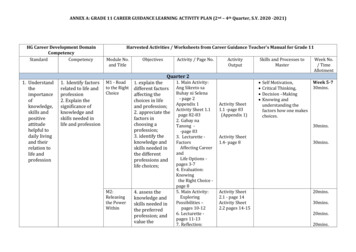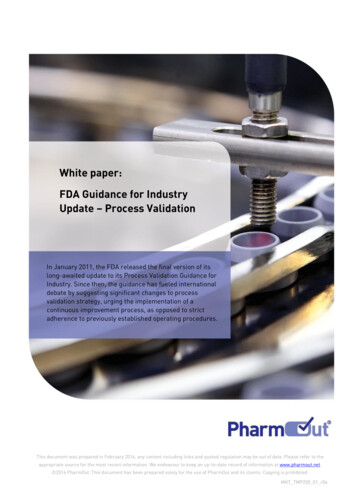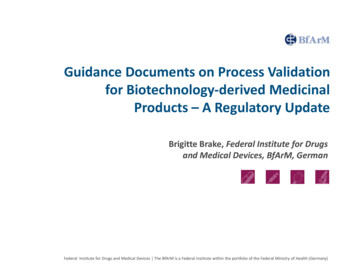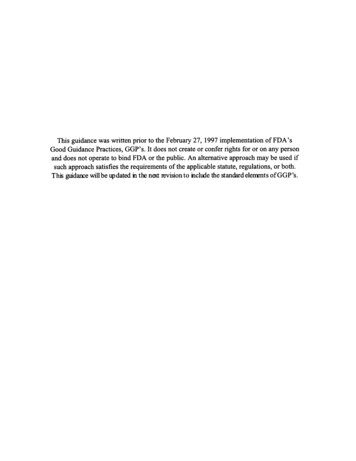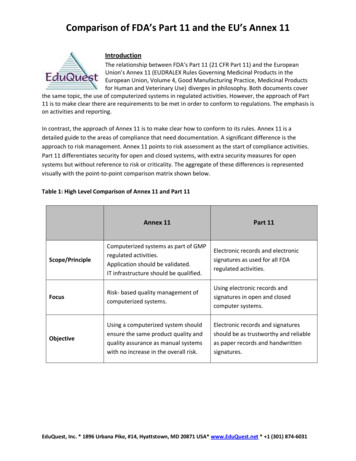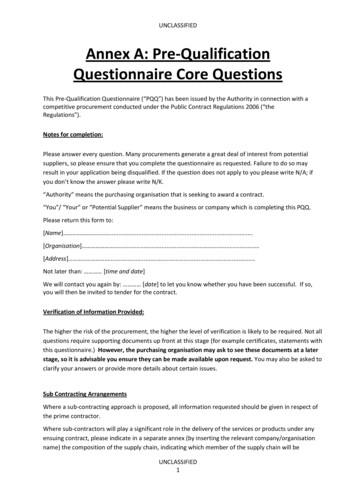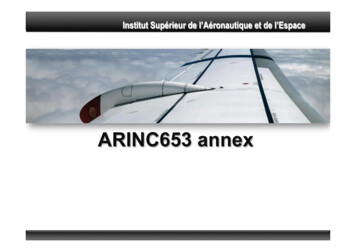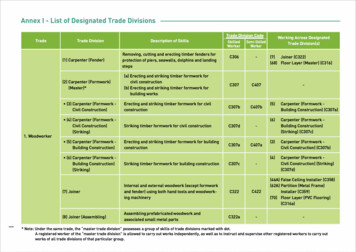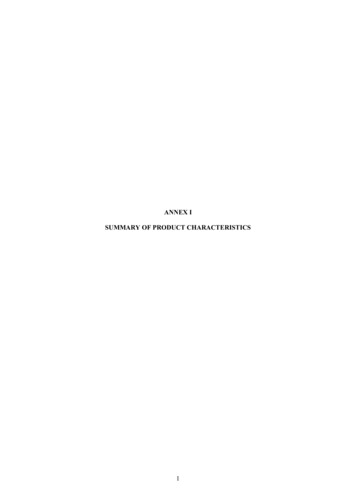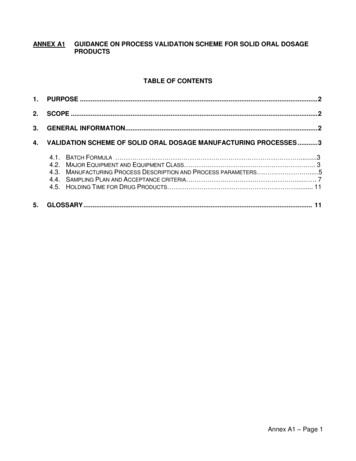
Transcription
ANNEX A1GUIDANCE ON PROCESS VALIDATION SCHEME FOR SOLID ORAL DOSAGEPRODUCTSTABLE OF CONTENTS1.PURPOSE . 22.SCOPE . 23.GENERAL INFORMATION. 24.VALIDATION SCHEME OF SOLID ORAL DOSAGE MANUFACTURING PROCESSES . 34.1.4.2.4.3.4.4.4.5.5.BATCH FORMULA .3MAJOR EQUIPMENT AND EQUIPMENT CLASS . 3MANUFACTURING PROCESS DESCRIPTION AND PROCESS PARAMETERS .5SAMPLING PLAN AND ACCEPTANCE CRITERIA . 7HOLDING TIME FOR DRUG PRODUCTS . 11GLOSSARY . 11Annex A1 – Page 1
1.PURPOSEThis document is intended to provide guidance for the process validation scheme of the manufacturingprocess of solid oral dosage formulations.This guidance document should be read in conjunction with the guidance listed below: ASEAN Guidelines for Validation of Analytical Procedures Current United States Pharmacopoeia, European Pharmacopoeia and JapanesePharmacopoeia Guidance for Industry, Process Validation: General Principles and Practices (FDA, January2011) CPG Sec. 490.100 Process Validation Requirements for Drug Products and ActivePharmaceutical Ingredients Subject to Pre-Market Approval SUPAC-IR: Immediate-Release Solid Oral Dosage Forms: Scale-Up and Post-ApprovalChanges: Chemistry, Manufacturing and Controls, In Vitro Dissolution Testing, and In VivoBioequivalence Documentation (FDA, 1995) SUPAC-IR/MR: Immediate Release and Modified Release Solid Oral Dosage FormsManufacturing Equipment Addendum (FDA, 1999) SUPAC-MR: Modified Release Solid Oral Dosage Forms Scale-Up and PostapprovalChanges: Chemistry, Manufacturing, and Controls; In Vitro Dissolution Testing and In VivoBioequivalence Documentation (FDA, 1997) Dissolution Testing of Immediate Release Solid Oral Dosage Forms (FDA, 1997)2.SCOPEThis guidance document applies to the solid oral dosage formulations – capsules, tablets and powder /granules for solution / suspension.3.GENERAL INFORMATIONThe presentations of solid oral dosage formulations are generally capsules, tablets and powder /granules for solution / suspension. Solid oral dosage products could be packaged as unit dosage formsuch as blisters and sachets or as multi units in the form bottles.Capsules are solid dosage forms in which the drug is enclosed in a hard or soft soluble shell,commonly made of gelatine or starch or other suitable substance. Capsules may be formulated forimmediate or modified release of drugs that may be in the form of powder, liquids or semisolids.Capsules can also be filled with uncoated or coated pellets, mini-tablets, powder or granules to permittransit through the stomach to the small intestine before the medication is released to alleviatepotential problems of drug inactivation or gastric mucous irritation, as in the case of modified releasedosage forms.Tablets are solid dosage forms that contain medicinal substances with suitable excipientsmanufactured by direct compression of powders or granules with the application of high pressures,using steel punches and dies. Tablets can be of any size, weight, colour and shapes, and may havesurface markings. Tablets can also be film-coated and/or have imprints.Annex A1 – Page 2
Powder / granules for solution / suspension may be presented in single dose units or multi-dose unitsand is required to be reconstituted in water before being administered orally. Presentations in multidose units may be used where strengths of each dose may not be critical.Process validation of a solid oral dosage form has to be specific to its batch formula and the operatingprinciples of equipment used for its manufacture. The process parameters that need to be controlledand / or monitored and testing that need to be conducted during process validation of a bulk solid oraldosage formulations depend on its method of manufacture and its presentation (compressed tablet,coated tablet, capsule, powder / granule). The acceptance criteria should take into consideration thenature of the solid oral dosage, for example its drug release characteristics (immediate release (IR) ormodified release (MR)). The following validation scheme can be used as a guide for process validationof solid oral dosage form and should be evaluated on a case-by-case basis.4.VALIDATION SCHEME OF SOLID ORAL DOSAGE MANUFACTURING PROCESSESThe following items should be taken into account for the execution of process validation of the solidoral dosage manufacturing process:4.1.Batch FormulaFor the execution of the manufacturing process validation, the batch formula of the solid oraldosage has to be well defined. All components of the dosage form to be used in themanufacturing process have to be listed, with their amounts on a per batch basis (includingoverages, if any).4.2.Major Equipment and Equipment ClassThe major equipment, used for the manufacturing process, are to be identified and the class ofeach equipment be indicated. The equipment are broadly categorized by the unit operation (forexample, blending and mixing, drying, particle size reduction, granulation, unit dosage, coating,encapsulation, printing, packaging). For each operation, the equipment is further categorizedby class (operating principle).The following lists some examples of equipment class for equipment of each major unitoperation, which are non-exhaustive.EquipmentEquipment ClassMixing TankBlenderConvective mixersDiffusion blender (Tumble)Convective blenderPneumatic blenderFluid energy millImpact millCutting millCompression millScreening millTumbling millMillAnnex A1 – Page 3
EquipmentEquipment ClassGranulatorDry granulatorWet high-shear granulatorWet low-shear granulatorLow-shear tumble granulatorExtrusion granulatorRotary granulatorFluid bed granulatorSpray dry granulatorDryersDirect Heating, Static Solids BedDirect Heating, Moving Solids BedDirect Heating, Fluidized Solids Bed (Fluid Bed Dyer)Direct Heating, Dilute Solids Bed, Spray DryerDirect Heating, Dilute Solids Bed, Flash DryerIndirect Conduction, Moving Solids BedIndirect Conduction, Static Solids BedIndirect Conduction, LyophilizationGas StrippingIndirect Radiant Heating, Moving Solids Bed (Microwave Dryer)Vibratory/ShakerCentrifugalGravityPower assistedRotary (centrifugal)Compression coatingPan coatingGas suspensionVacuum film coatingDip coatingElectrostatic coatingAugerVacuumVibratoryDosing diskDosatorPositive displacement pumpGravity or force fedMixers and Mixing VesselsDeaggregatorsDeaeratorsHolding VesselsVacuumAugerPlate-typeSeparatorsTablet PressCoating machineEncapsulator (hardcapsule)Encapsulator (softcapsule)Powder fillerBlister packagingmachineBottle packagingmachineNone identifiedAnnex A1 – Page 4
The product owner / applicant will determine the level of equipment information to beregistered. Where information on the equipment class is deemed critical but not made availablein the submission, the Drug Regulatory Authority (DRA) reserves the right to request for suchinformation.4.3.Manufacturing Process Description and Process ParametersThe manufacturing process may be described or presented in a flow diagram.The following process parameters are recommended to be controlled or monitored as part ofthe process validation, depending on the dosage form and the type of manufacturing process.The process parameters listed below are non-exhaustive. They serve only as examples andmay differ depending on the class of equipment used.Process StepTablet Capsule PGSProcess ParametersRaw Materials Sieving, ifrequiredPremix, if required Mesh / sieve size Mixing time, speed, loadsizeFill liquid mixing, ifrequiredNA NA Mixing time, speed,volumeDry milling (particlesizing), if applicableDBDBDB Screen size Milling speed Feed rate Blending time, load size,speed Sieve size, for dryblending, if required Binder amount,concentration Temperature Load size Mixing time, speed Temperature Rate of liquid addition Application spray patternFinal BlendingGranulation binderpreparationGranulation WGWG WGWG WGWGAnnex A1 – Page 5
Process StepTablet Capsule PGSProcess ParametersWet milling (if applicable)WG Rounds per minute Pressure TemperatureWet screening (ifapplicable)DryingCoolingTabletting (includingMetal detection andDedusting)WGWG Mesh / sieve sizeWGWGWG Drying time Temperature distribution Cooling Time Cooling Set Temperature Compressing machinesettings Tabletting speed (tbs/hr) Temperature Mixing speed / time Load size Coating pan settings Temperature Spray rate Rounds per minute Air flow rate Printing feed rate(units/hr) Temperature Capsule machine settings Machine speed (caps/hr) Feeding system Machine settings Machine speed Feeding speedWG Coating (if required) Capsule filling (includingdedusting)Primary packagingWGWGCoating solution /suspension preparation (ifrequired)Printing on product (whenrequired)WG NA WGNA WGNANANANANA Annex A1 – Page 6
Process StepTablet Capsule PGSProcess ParametersEnvironmental monitoring– throughoutmanufacturing process Temperature Relative humidity (Applicable for heat and / ormoisture sensitive productsonly)Where PGS denotes Powder / Granule for Solution / SuspensionDB denotes applicable for Dry Blending onlyWG denotes applicable for Wet Granulation only denotes applicable (if required)NA denotes Not ApplicableThe product owner / applicant will determine the level of process information to be registered.Where process parameters are deemed critical but not well defined in the submission, the DRAreserves the right to request for such information.4.4.Sampling Plan and Acceptance CriteriaIt is the responsibility of the manufacturer to ensure that the sampling plan and acceptancecriteria defined are adequate to ascertain that the manufacturing process is well-controlled androbust to produce drug product consistently meeting specifications. The following samplingplan and acceptance criteria provide a guide for the process validation of a typical solid oraldosage manufacturing process with medium risk indication.StageSampling PlanTestAcceptance CriteriaDrying, if requiredAt least 3 samplesfrom at least threedifferent locationsor time pointsthroughout theoven chamber ordrying process(1).At least 3 samplesfrom at least tendifferent locationsevenly distributedthroughout themixer(1)(Twenty locationsfor convectiveblender)Loss on drying(LOD) – analyze onesample per locationBased on productionspecification for LODBlend / Mixuniformity (Assay) –analyze one sampleper locationStage 1 Individualresults: Mean 10%(absolute)Final Blend / MixIf required, Flowability Density AppearanceAll individual results:RSD 5.0%In-houseAnnex A1 – Page 7
StageSampling PlanTestAcceptance CriteriaComposite sample *VisualinspectionUniformity: As percompendia *Uniformity(may be performed aspart of release testing) Microbial Limit Test(MLT): As per*Assay (Potency) compendial MLTmethod*Impurities *Microbialcontamination Other internalspecificationsOthers: Compendia /In-house* May be omitted if nextstep is tabletting and / orencapsulation.TablettingStratified sampling Uniformity Any otherinternalspecifications, ifrequiredComposite sample Visual inspection(may be performed aspart of release testing) Uniformity Assay (Potency) Friability **Hardness **Disintegration **Dimension **Dissolution **Impurities **Microbialcontamination Other internalspecificationsUniformity: As percompendiaOthers: Compendia /In-houseUniformity: As percompendiaMLT: As percompendial MLTmethodOthers: Compendia /In-house** May be performedafter coating and / orencapsulated, ifapplicable.Annex A1 – Page 8
StageSampling PlanTestAcceptance CriteriaCapsule fillingStratified sampling Uniformity Visual inspectionUniformity: As percompendia Length of filledcapsulesOthers: Compendia/In-houseComposite sample Visual inspection(may be performed aspart of release testing) UniformityUniformity: As percompendia Assay (Potency) DimensionMLT: As percompendial MLTmethod Dissolution/DisintegrationOthers: Compendia /In-house Impurities Microbialcontamination Other internalspecifications Assay (forcoating of activeonly)Coating1 sampling fromeach coating pan At least tenlocationsdistributedthroughout allbatchsubdivisions(1)Assay: In-houseMoisture / solvent:ICH guidelinesMoisture content/ residual solventUniformityAs per compendiaAnnex A1 – Page 9
StageSampling PlanTestAcceptance CriteriaComposite sample Visual inspection(may be performed aspart of release testing) Uniformity (foractive coatingonly)Uniformity: As percompendia Assay (Potency) ***Hardness ***Disintegration ***Dissolution ***Impurities ***Microbialcontamination Other internalspecificationsOthers: Compendia /In-house*** May be omitted ifencapsulatedPrintingStratified samplingVisual inspectionIn-houseFilling of powder /granules intobottlesPrimarypackaging (may beStratified samplingWeight uniformityLabel claim 5%(absolute)Stratified sampling Visual inspectionIn-house CCS integritytest, if required Temperatureperformed as part roughout themanufacturingprocessIn-house Relative humidity(Applicable for heatand / or moisturesensitive productsonly)Where RSD denotes Relative Standard DeviationICH denotes International Conference on Harmonisation of Technical Requirements for Registration ofPharmaceuticals for Human UseMLT denotes Microbial Limit TestCCS denotes Container Closure System(1)Note: Other sampling plans may be acceptable if they are statistically sound and justified.The extent of sampling, tests and acceptance mus
Process validation of a solid oral dosage form has to be specific to its batch formula and the operating principles of equipment used for its manufacture. The process parameters that need to be controlled and / or monitored and testing that need to be conducted during process validation of a bulk solid oral dosage formulations depend on its method of manufacture and its presentation .
